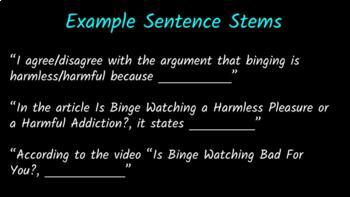Argument, Claim, & Evidence Practice - Is Binge Watching TV Harmful or Harmless?
- Google Slides™

What educators are saying
Description
This presentation can be used as a pdf or Google Slides Presentation with Peardeck Add-On. This is great quick practice for 7th-8th grade students struggling with creating argument claims or writing argumentative paragraphs. The Peardeck Add-on makes this digitally interactive for your students. Simply find the Peardeck add-on in Tools and present using the Present button. Have students enter the code given into joinpd.com. This presentation works similar to Nearpod.
There are two Youtube videos embedded and a NewsELA article with pro and con sections. The culminating task in this lesson is for students to write an argumentative paragraph taking one side of the argument about binge watching television being good/bad for people. There are example sentence stems for further assistance following the writing prompt and a link to the Google doc version of the article.
I would suggest using the Google doc version for additional practice highlighting pro/con claims or reasons.





